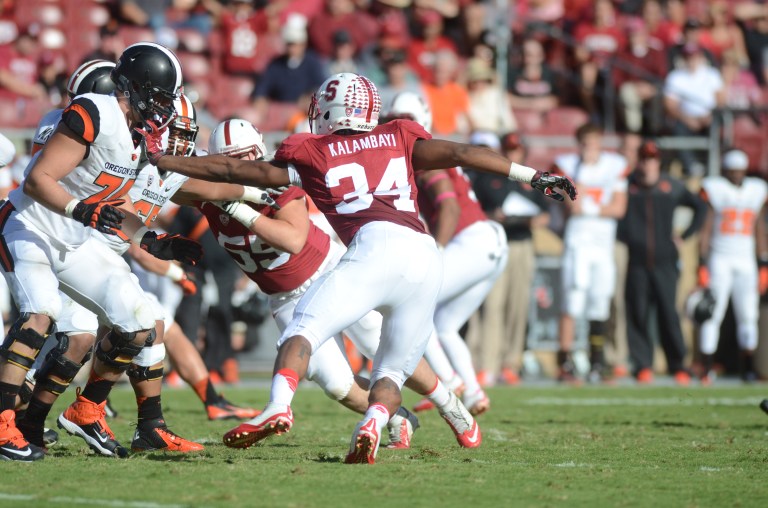With the football season now three weeks away, Daily football writers Do-Hyoung Park, Vihan Lakshman and Michael Peterson offered their opinions on several questions regarding the 2015 Stanford defense in the second part of the roundtable preview series for the Cardinal’s upcoming campaign.
Week 1: Offense roundtable
Week 2: Defense roundtable
Week 3: Special teams, schedule roundtables
The Cardinal have allowed fewer than 20 points per game in four of the past five seasons, even after losing multiple stars with the departures of Chase Thomas and Terrence Stephens in 2013 and Shayne Skov, Trent Murphy, Ed Reynolds and more in 2014. However, Stanford returned at least six defensive starters in all five of those seasons. Can the Cardinal repeat the defensive feats of past units with just three returning starters?

Do-Hyoung Park (DHP): Stanford’s defense has now finished in the top 30 in the nation in total defense in each of the last five seasons. How it doesn’t at least get the benefit of the doubt despite its losses is beyond me. The Cardinal haven’t ridden once-in-a-generation star power to stellar defenses; rather, it’s a sound scheme, hard-nosed players and tremendous coaching that have allowed Stanford to maintain that consistent success. Sure, Stanford is losing a bit more proven talent than usual, but Stanford isn’t exactly plugging in fresh faces: Kodi Whitfield, Dallas Lloyd, Ronnie Harris and Terrence Alexander all saw lots of action last year, and as their position coach is the best collegiate DB coach in the country, I’m not going to sound the sirens on the secondary yet. And while you can point to last year’s offensive line as an example of talent not necessarily equating to success, defensive line is the position where one or two talented guys can have the biggest impact (see: Suh, Ndamukong; Watt, J.J.), and by all accounts, Solomon Thomas and Harrison Phillips are oozing talent. I’m going to have every bit of faith that this defense can stay the course until proven otherwise.
Vihan Lakshman (VL): If I have learned anything over the last three years at Stanford, it’s to not bet against the Cardinal defense. This unit seems to have the supernatural ability to absorb the annual offseason skepticism and become even stronger, at least statistically, than it was the year before. But this year will be a different type of challenge for Lance Anderson’s crew as it must work to replace almost two entire levels of the defense: the secondary and the D-line. As we saw with the growing pains of breaking in a nearly brand-new offensive line last season, it’s hard to build that on-field cohesiveness within a position group right away. At this point, the Stanford defense should earn the benefit of the doubt and we saw this group make massive strides during spring ball, culminating in a thrashing of the offense during the Cardinal and White Spring Game. Nevertheless, replacing a position group almost entirely is a fiendish obstacle to overcome, and, while it will still be one of the premier units in the conference, I don’t expect this defense to match the eye-popping numbers put up over last couple of years.
Michael Peterson (MP): There’s no question that the Cardinal’s “next man up” philosophy has worked wonders in the past, but this is a much more daunting challenge for the defense. Losing the entire starting secondary and defensive line hurts, especially given the relative inexperience of the players stepping into starting roles this year. That being said, if this were Alabama we were talking about, no one would doubt the Tide’s ability to reload and reproduce. Given the level of play of Stanford’s defense over the last few seasons, it’s time to put the Cardinal in that same category and recognize the coaching staff’s great recruiting and player development efforts — this has been an elite defense without individual elite NFL talent (no first-round picks and only one second-round pick). Stanford is absolutely capable of maintaining its defensive dominance, but this is the coaching staff’s toughest task yet.
Which lost player will prove to be the hardest to replace for the Cardinal?
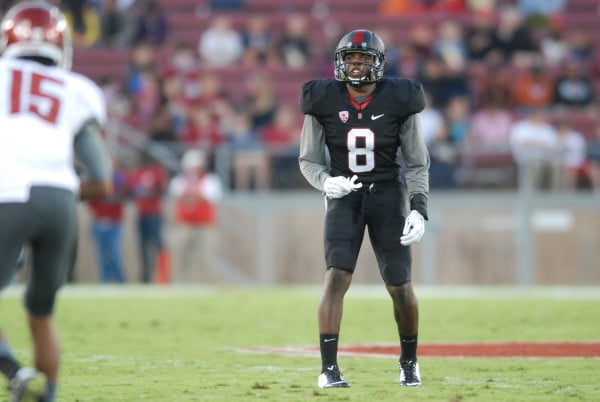
DHP: It’s arguably the least glamorous position on the Cardinal’s 3-4 defense, but the importance of the nose tackle absolutely cannot be understated. David Parry didn’t fill up boxscores with heaps of sacks, but when he was missing last season, the Cardinal defense lost its stalwart up the middle around which it built its entire scheme. Without Parry’s 300-pound, wedge-like frame swallowing double teams and harassing the middles of opposing offensive lines, Stanford’s inside linebackers and safeties would have had a much more difficult time defending runners that would have hit the second level with much more freedom and frequency. And when an opponent opens up its running game, its passing game opens up as well. Stanford’s only true nose tackle is true freshman Wesley Annan, and the Cardinal will need to turn to converted DEs Harrison Phillips and Aziz Shittu to try and emulate Parry’s quiet, consistent production. If they can’t, don’t be surprised to see the Cardinal defense looking a little more beatable than usual.
VL: I’m going to go with Stanford’s highest selected defensive player in the 2015 draft: Jordan Richards. The backbone of the Cardinal secondary since making his first start as a true freshman, Richards provided vital reliability at the safety position, both in coverage and in stuffing the run. Moreover, his leadership and intelligence also made him the de facto quarterback for the defense, a trait especially difficult to replace. With the loss of his heir apparent Zach Hoffpauir to the Arizona Diamondbacks, the task of replacing Richards, a former team captain, will prove to be even more difficult than previously anticipated and one that may come to define Stanford’s season.
MP: When Royce Freeman, Devontae Booker or Buck Allen burst through the first level of the defense last year, Stanford could count on safety Jordan Richards to make the tackle as the last line of defense between the back and the end zone. Now, Richards is gone and the near-guarantee of a touchdown-saving tackle on runs that break into the secondary vanishes with him. While Dallas Lloyd projects as a athletic safety quick enough to get in front of running backs and strong enough to stop them, he has only one full season of experience as a safety at the college level with little playing time outside of special teams. Richards’ sure-handedness will be greatly missed.
Among the new starters, which player is most likely to have a breakout year?
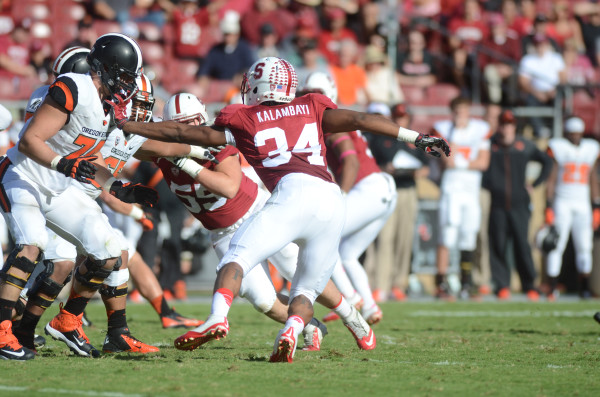
DHP: Although his emergence has almost been swallowed up by all of the hype surrounding classmate Solomon Thomas, I don’t think there will be many players more valuable to the Cardinal this season than Harrison Phillips. Remember that last season, when Parry got injured, the coaching staff turned to the then-255-pound Phillips to fill in at nose tackle. And despite his overwhelming lack of size and raw technique, he actually did pretty darn well — against Arizona State and Oregon, no less. Now imagine what he can do with 23 extra pounds of beef on his sturdy frame and a full offseason of coaching from Randy Hart. Yikes. But Phillips’ true value will come from his flexibility: Although he was recruited as a DE, he’s now listed as a DT/DE, giving him the ability to fill in at one of Stanford’s positions of greatest need and bring big-game experience at his newer position to the table. Watch out, Pac-12: #Phillips66 is coming to a town near you.
VL: During Pac-12 Media Day, David Shaw mentioned that outside linebacker Peter Kalambayi could become a nationally recognized name when the dust settles at the end of the season, and I couldn’t agree more. Kalambayi is an explosive athlete at 6-foot-3, 242 pounds, and he appears poised to embrace the role of terrorizing opposing quarterbacks as the starting outside linebacker after learning from Trent Murphy and James Vaughters over the past two seasons. We got a taste of what a monster Kalambayi can be last season as he racked up 6.5 sacks, the second-most on the team, as a reserve, and also became the first Stanford defender to record three sacks in a game since Shayne Skov in the 2011 Orange Bowl. Stanford has produced a series of top-notch pass rushers over the past few years, and Kalambayi looks ready to add to that lineage.
MP: Please take a look at this picture, then look me in the eyes and tell me that Solomon Thomas isn’t going to demolish opposing running backs, quarterbacks and offensive linemen this year. Thomas has drawn rave reviews from coaches and teammates alike and has added around 20 pounds of muscle since coming to Stanford a year ago as a five-star recruit. He’s never played a snap and Phil Steele still put him on the preseason All-Pac-12 third team. It wouldn’t surprise me if Thomas posted double digits in tackles for loss and sacks.
Can Duane Akina turn the talented yet extremely inexperienced secondary into an asset for Stanford?
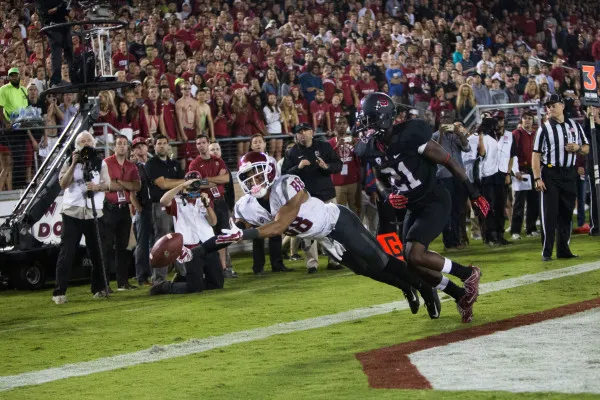
DHP: The idea that Stanford’s secondary is “extremely inexperienced” has got to be the biggest misconception that people have about Stanford’s defense this offseason. Whitfield and Lloyd played in a combined 21 games last season. Ronnie Harris is a fifth-year senior that was a starter last year. Terrence Alexander played in every game in 2014. Now, the depth (Taijuan Thomas, Alijah Holder, Alameen Murphy, Ra’Chard Pippens) is a lot less tested, but that’s not really all too different from the situations in years past. And again, Duane Akina is the king of developing young defensive backs. The unit will clearly miss Alex Carter and Jordan Richards, but I don’t think the drop-off is going to be as crazy as people think. I can’t say for sure that the secondary will be an asset, but I’d be shocked if it’s a liability.
VL: I wouldn’t doubt Coach Akina for an instant. Everyone may have their favorite gripes about Shaw, but one thing you cannot criticize Stanford’s head man over is his ability to hire top-notch assistant coaches, and bringing Akina over from Texas is no exception. Akina’s record of developing talented young defensive backs speaks for itself, but I’ll be more interested in watching how he will work with Dallas Lloyd and Kodi Whitfield, two former offensive players who will likely be thrust into starting roles in Week 1. We know Akina can take highly touted DB recruits and get them ready for the next level, but it might be even more fun to see how he can guide two veteran players who switched positions midway through their careers.
MP: Next season, I believe the secondary will be one of Stanford’s greatest strengths. Current sophomore cornerbacks Terrence Alexander, Alijah Holder and Alameen Murphy will have a year of playing experience under their belts while highly touted freshmen Frank Buncom and Quenton Meeks — both built in the same physical mold as Richard Sherman — will have been at the college level for a year, in addition to the young, talented safeties, Brandon Simmons, Ben Edwards and Justin Reid, growing in experience. This year, though, the unit is unquestionably inexperienced outside of Ronnie Harris and Terrence Alexander. Given Akina’s history at Texas, he very well could extract that talent and turn this into the team’s strength a year ahead of schedule. At least early in the season, though, I expect there to be a steep learning curve for the young unit.
How will Stanford cope with losing all three starters on the defensive line, especially at defensive tackle, where the only player on the roster at the position (Wesley Annan) is a freshman?
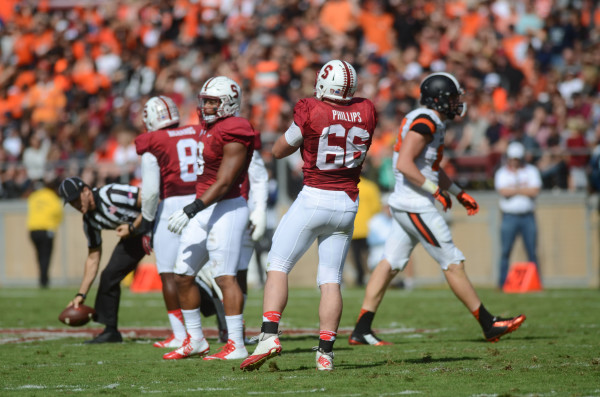
DHP: As I alluded to in my earlier responses, I’m certainly more sure about the defensive line than I am about the secondary — and I’m reasonably confident in the secondary. Solomon Thomas and Harrison Phillips are going to be impact NFL players one day, and I’m extremely confident that they will look the part this year. The depth is there with the returns of a revitalized Aziz Shittu and Nate Lohn, along with the transfer addition of Brennan Scarlett. Despite the lack of a true nose tackle, I think Phillips is going to emerge as a huge threat in that position when given the opportunity. The only thing that worries me is the size: Shittu is listed as the heaviest at 279 lbs., and even with good technique, it will be difficult for the line to get push against, say, USC and its absurdly talented group of 310-plus-pound cinderblocks with arms that it calls an offensive line. If they can continue to bulk up as the season goes on, I’ll be completely sold.
VL: On National Signing Day, Shaw remarked that if Annan is ready to play as a freshman, Stanford will not hesitate to plug him in at the start of the season, and that speaks a lot to the Cardinal’s lack of a disruptive defensive tackle in the middle. In Stanford’s 3-4 defensive scheme, the defensive line is primarily responsible for getting early penetration and disrupting opponents’ running game. An understated aspect of Stanford’s D-line dominating over the last couple of seasons was not only the stellar play of Parry and Henry Anderson individually, but also their synergy and comfort playing with each other over the course of two seasons (which they’ll now be bringing to Indianapolis). If Annan is not ready to go right away, Aziz Shittu and Harrison Phillips are more than suited for the nose tackle job, but the key question to watch is how the revamped defensive line can function as a unit without a significant amount of experience playing together.
MP: Count me as a believer in the defensive line. Replacing David Parry, as Do touched on before, will be the toughest task for the unit, but David Shaw has repeatedly emphasized how college football is morphing more and more into a nickel defense game, with four down linemen, two linebackers and five defensive backs, in which case Stanford doesn’t need a true nose tackle. Additionally, though no one player can replace Parry, the three projected starters in Shittu, Thomas and Phillips all weigh north of 270 pounds and are capable of successfully stepping into that role for a few plays in a rotation. With talented players like Brennan Scarlett and Jordan Watkins ready to provide relief at the defensive end position, we may see Stanford try to replace the three departing starters by using almost a “defensive-line-by-committee,” keeping the undersized nose tackles fresh and able to give it their all for a few plays at the position.
Which player’s performance is most vital for the defense to succeed in 2015?
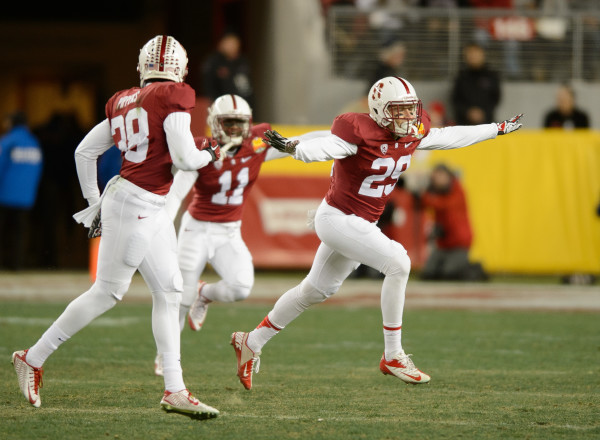
DHP: I feel like I’ve been talking about the defensive line way too much, so I’m going to give the other guys some love and go with Ronnie Harris for this pick. Ronnie came out strong at the end of last season, outplaying Wayne Lyons down the stretch to snatch Lyons’ starting spot. With Alex Carter leaving, though, Ronnie is going to need to take his game to the next level to match Carter’s absolute shutdown of opposing No. 1 receivers. Stopping the run game won’t do much if you get beaten over the top anyway, and with guys like Nelson Spruce (Colorado), JuJu Smith (USC), Byron Marshall (Oregon) and others ready to challenge the Stanford secondary, Harris’ success is going to be critical to stop the Pac-12’s dynamic offenses.
VL: As we talked about earlier, Stanford’s defensive line will need to get into opponents’ backfields consistently to stuff rushing attempts and disrupt the notoriously pass-happy Pac-12 offenses. Aziz Shittu displayed this ability through the first five games of last season before going down with a knee injury, and the Cardinal will be counting on their most experienced defensive lineman to be a decisive factor up front. Shittu also has the versatility to play in the defensive tackle slot, which could significantly enhance Stanford’s ability to rotate players. A strong 2015 campaign from Aziz should set the tone for the rest of the defense.
MP: I’m cheating and choosing two players — Dallas Lloyd and Kodi Whitfield. As I touched on before, replacing Jordan Richards might be the defense’s Achilles heel, and Stanford needs Dallas Lloyd to be the physical tackling presence in the second level to prevent big plays off of broken tackles in the first level. However, the young cornerbacks also need quality assurance over the top in case they get beat — which is bound to happen for young cornerbacks — in man-to-man. That’s where Kodi Whitfield comes in. If Lloyd and Whitfield perform their respective duties, then that will help the defense avoid surrendering big plays, a key for this unit to succeed.
True or false: The defense must hold opponents to under 20 points per game if Stanford is going to win the Pac-12.
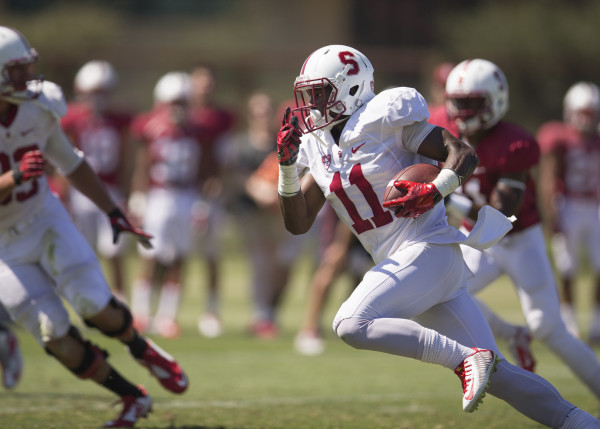
DHP: False. Twenty points is an unreasonable standard, especially in the Pac-12 — even for a defense that has actually met this standard in four of the last five seasons. A championship team should have good balance — that’s why you don’t see Baylor or Virginia Tech winning any titles (or 2014 Stanford, for that matter). What the defense does need to do to win the Pac-12 is to maintain consistency and just make sure that the offense is never out of a game. In addition, it must force turnovers more effectively. Stanford’s turnover margin last year was -5, and if a ball-control team like Stanford can’t generate takeaways, it puts a lot more stress on the bend-but-don’t-break unit that Stanford has become.
VL: False; no defense should be expected to hold opponents under 20 points per game in order for a team to win, especially with how the rules governing pace of play are heavily stacking the deck in favor of offenses in college football. What Stanford’s defense did last season in holding all but two opponents under 20 points per game was remarkable, but compensating for an anemic offense shouldn’t have to be a prerequisite for winning. Instead, the focus of the defense should be consistency and avoiding those lackluster performances like giving up 42 points to Oregon last season or 48 to Arizona back in 2012. If the defense can avoid those disaster-type weeks, even if that means failing to hold an opponent under 20 points, Stanford — with what looks to be a much-improved offense — should be fine.
MP: False, but with a caveat. The offense is good enough this year that Stanford can afford some regression on defense, but I don’t believe Stanford will ever beat Oregon again because its offense was superior, as was the case in 2009. Oregon’s offense is one of the best in the country and will likely be that way for a long time. If Stanford is going to down the Ducks and win the Pac-12 North, it will be because the defense stepped up again and gave Stanford enough of an edge to overcome the offensive disparity. The defense clearly won the Oregon game in 2012, and though Gaffney and the offensive line deserve major credit for the 2013 Oregon victory, it was only possible because the defense kept the early lead by forcing a red-zone turnover on downs, a red-zone fumble, another fumble on a long drive and two three-and-outs. The amended truth is that Stanford needs its defense to play at a high level against Oregon in order to win the Pac-12 North.
Contact Do-Hyoung Park at dhpark ‘at’ stanford.edu, Vihan Lakshman at vihan ‘at’ stanford.edu and Michael Peterson at mrpeters ‘at’ stanford.edu.
